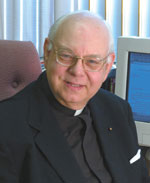Solemnity of the Most Holy Body and Blood of Christ, Corpus Christi /
Msgr. Owen F. Campion
The Sunday Readings
 The Book of Exodus is the source of this feast day’s first reading. It recounts the story of an event that occurred as the Hebrews were making their way across the Sinai Peninsula, in flight from Egypt and slavery.
The Book of Exodus is the source of this feast day’s first reading. It recounts the story of an event that occurred as the Hebrews were making their way across the Sinai Peninsula, in flight from Egypt and slavery.
To modern ears, the story may sound gruesome, giving the details as it does of the ritual sacrifice of a young bull. It is necessary to recall that these instructions were given long ago.
They also long ago passed out of Jewish religious ceremonies. But the meaning of these ancient sacrifices still has a message. For example, the ceremony in this case required that the blood be sprinkled on the people.
The idea was that life in a special way resided in the blood of a creature. It is not difficult to understand how this notion originally arose. The ancients had a very limited knowledge of physiology, but they knew if the blood stopped flowing, the creature died; if enough blood escaped from the body due to injury, then death followed.
Offering the bull to God made the bull holy. Its blood therefore was holy, and that meant the blood somehow was touched by God’s own life. By sprinkling this blood on the people, they in turn were touched by God in a special way.
Beyond these circumstances, the lesson is that from the earliest stages of revelation, God used processes and materials that people understood and could access to assist them in expressing themselves in their religious faith.
The Epistle to the Hebrews is one of the New Testament’s most eloquent sources for knowledge about the person and the mission of the Lord. This feast’s selection is no exception.
This particular reading stresses that Jesus is the perfect victim of sacrifice as well as the great high priest. The sacrifice of bulls is no longer necessary. In its place is the sublime offering of the innocent Lamb of God, Jesus the Lord.
The three Synoptic gospels report the institution of the Eucharist by giving the actual words used by Jesus at the Last Supper: “This is my body” (Mk 14:22), and “This is my blood” (Mk 14:24).
In this feast day’s case, the reading is from Mark’s Gospel. Before the mention of the meal itself, the Gospel says that Jesus sent two disciples into the city. He told them that they would see a man carrying a water jar. They should follow this man.
The man will go to a house, Jesus said, whose owner the disciples should ask for a room in which the Lord and the disciples could gather to eat the Passover meal.
It is an interesting passage. It reveals that the Last Supper—and all that happened at the Last Supper—was utterly within the providence of God. It was no ordinary meal. God planned that it would provide the means for uniting with Jesus.
Reflection
Biblical scholars long have studied the words, “This is my body,” “This is my blood.” They often view it from the perspective of their own Christian tradition. In other words, many Protestant scholars see them as symbolic. Catholic scholars see them as literal. The early Church, by the way, saw them as literal.
Strictly from the standpoint of the language, the words are brief, direct and clear. Look at them without any predispositions. Read them as they appear. The message is unambiguous. The bread and wine become the body and blood of Jesus.
This holy body and blood actually become part of the person who consumes them, as the body absorbs any nourishment. In this consumption, the person becomes one with Christ, and Christ with the person. Christ is God.
The nourishment therefore is from God and is God. It intimately unites us with God. That is an important reason why we call it holy Communion. †
 The Book of Exodus is the source of this feast day’s first reading. It recounts the story of an event that occurred as the Hebrews were making their way across the Sinai Peninsula, in flight from Egypt and slavery.
The Book of Exodus is the source of this feast day’s first reading. It recounts the story of an event that occurred as the Hebrews were making their way across the Sinai Peninsula, in flight from Egypt and slavery.